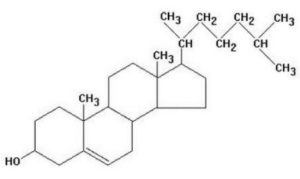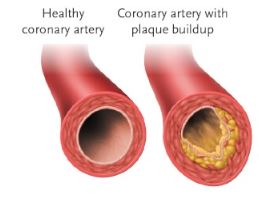When someone says “I have high cholesterol”, what they actually mean is that they have high LDLs, which are low density lipoproteins where cholesterol is just one component of group of molecules. Dietary cholesterol is one single molecule and has important biological functions in our body.
Dietary Cholesterol
Cholesterol is shown in the following diagram. This is the cholesterol molecule found in dietary sources like meat, eggs, and dairy. Cholesterol is also produced by our liver.

Cholesterol is a fat molecule composed only of carbons and hydrogen and 1 oxygen, that is used in the body to:
- Make bile – the liver makes and uses dietary cholesterol molecules to produce bile that is transported to the gallbladder and then emptied into the small intestine to emulsify dietary fats so that we can digest and absorb them
- Make cell membranes – the main fat molecules of all cell membranes are phospholipids but cholesterol molecules are also incorporated into cell membranes and play an essential role in maintaining proper cell fluidity
- Make steroid hormones – many steroid hormones are produced from cholesterol molecules including estrogens, progesterone, androgens like testosterone and DHEA, cortisol, and aldosterone.
- Is a component of lipoproteins – molecules that are combinations of fats and proteins that transport fat through the bloodstream…aka “blood cholesterol”
Blood Cholesterol
There are 2 major categories of blood cholesterol, the LDLs (low density lipoproteins) and HDLs (high density lipoproteins). The diagram below shows that each type has a different composition of various molecules, mainly subforms of apolipoproteins (APO).
HDLs are considered the “good” blood cholesterol.
LDLs are considered the “bad” blood cholesterol.

Fats are not water-soluble and our blood is composed of water, so lipoproteins have fat-soluble and water-soluble components that allow fats to be transported in the blood. Lipoproteins also interact with lipoprotein receptors on our cells, which allows cells to take up the lipid-protein molecules and use the fat component for energy production when blood sugar levels decrease.
A short description of some of the APO molecules
APOAs – major structural protein component of HDLs, primarily involved in bringing fat and cholesterol molecules from stored fat in adipose tissue to the liver and also a main component of the chylomicron formation, which are the molecules made in the small intestine cells when we first absorb fats from food. Also involved in feeling satiated after eating a meal.
APOB – primary organizing and transport proteins in lipoproteins from the liver to stored adipose tissue. Note that LDLs are primarily composed of this type and it why higher blood LDLs are associated with higher risk of heart disease….because it indicates that more fat is being stored than used.
APOCs – important role in fat metabolism, specifically the metabolism of lipoproteins rich in triglycerides – which is the type of fat we use for energy. – Notice in the chart above how HDLs have APOCs. This is why higher blood HDL levels are associated with a reduced risk of heart disease.
APOE – plays an important role in binding to lipoprotein receptors. This is when fats traveling in lipoproteins in the bloodstream can bind to cells and then be taken up and used by the cells. LDLs and HDLs can be taken up and used by cells.
There are 2 types of LDLs - they are not all “bad”
Pattern A – large LDLs – generally not associated with cardiovascular disease
Pattern B – small LDLs – these seem to be more highly associated with a higher risk of cardiovascular disease. The smaller LDLs are more readily able to penetrate the blood vessel wall, which builds up in combination with immune cells and this is called plaque. When a significant amount of plaque builds up in the blood vessel walls, then it is called atherosclerosis, which leads to narrowing of the blood vessels and a blockage can cause various conditions such as a heart attack or stroke.

Oxidized LDLs – most associated with cardiovascular disease. When fats circulating in the blood are damaged by free-radicals, this stimulates the immune system to trigger an inflammatory response, which is your body’s effort to remove the damaging substance. This process is why inflammation is so highly linked with cardiovascular disease. Circulating LDLs can be oxidized by toxins (such as from pollution or smoking), from free-radicals produced by the immune system during infection or by the muscles during intense exercise, a lack of antioxidants (from not eating plant foods), or by the stress response, which is why stress is so highly correlated with heart disease.
VLDLs – very low density lipoproteins. These are similar to LDLs except that they tend to carry more triglycerides than cholesterol. Higher blood values usually tend to indicate higher triglyceride levels, which is from eating excess total calories or from having unstable blood sugar – such as insulin resistance or diabetes. You can also temporarily have higher VLDLs if you sugar binge. VLDLs can also build up in blood vessel walls and contribute to atherosclerosis, especially if they become oxidized.
What are you seeing in your blood results? (Canadian units are mmol/L)
Blood lipid | Normal values | What it means |
Triglycerides | < 1.7 | Measures free triglycerides, the type of fat we store in fat cells. Free triglycerides usually indicate high blood sugar since excess sugar is converted into fat. Most common cause of high triglycerides is uncontrolled diabetes. |
Total cholesterol | < 4.5 (under age 20) < 5.2 (over age 20) | Measures the total amount of HDLs and LDLs, not very useful info, better to know LDLs and HDLs individually |
HDL cholesterol | > 1.0 (men) > 1.3 (women) | Measures HDLs, a higher value indicates that your body is using stored fat for energy. Low HDL levels most commonly occur with unstable blood sugar and excess body fat. You can increase HDLs with intermittent fasting and exercise because it makes your muscles use stored fat for energy. |
Non HDL cholesterol | < 3.37 | Measures your total cholesterol minus the HDLs, which includes LDLs and VLDL (very low density lipoproteins) which can also play a role in heart disease. |
LDL cholesterol | < 3.4 | Measures LDLs transporting fat to fat cells for storage. High levels indicate it is not being dropped off and stays in circulation, this could be trans fat or oxidized fat that the cells can’t use. High LDLs can also indicate excess total calorie intake since all extra calories are converted into fat and have to be transported. This test does not differentiate pattern A vs pattern B LDLs! |
Cholesterol/ HDL cholesterol | < 4.11 | This is a ratio of your total cholesterol divided by your HDL level. Suppose total cholesterol is 4.8 and HDLs are 1.3, then ratio is 4.8/1.3 = 3.6, anything under 4.11 is good. Higher ratios simply mean you have more LDLs and VLDLs than HDLs and therefore, higher ratios = higher risk of heart disease. |
Does dietary cholesterol increase blood cholesterol?
This is the question that has had researchers debating since the 1960s. The latest studies are showing that eggs, red meat, and dietary cholesterol are not associated with blood cholesterol and are not associated with heart disease. It seems there is more evidence pointing towards trans fats, oxidized fats, sugar, and excess total calories, and lack of exercise being the primary culprits linked to atherosclerosis.
The studies that associated high dietary cholesterol with increased cardiovascular disease looked at populations of people consuming unhealthy diets of fast food and processed food. We can’t blame the dietary cholesterol when there are so many other factors involved. People that tend to eat more fast foods tend to exercise less, drink more alcohol, and eat fewer vegetables so they have several variables contributing to atherosclerosis.
There are a lot of people that follow a Paleolithic or ketogenic diet that involves eating foods containing cholesterol…. interestingly, they do not have more heart attacks. They also do not eat fast food, processed food, refined oils, added sugar and refined carbs, and they do eat a lot of vegetables. A systematic review in 2019 revealed that people on a paleo diet had lower body weight, smaller waist circumference and reduced cardiovascular risk factors even though they consume dietary cholesterol.


Very well written and easy to understand post Wendi.